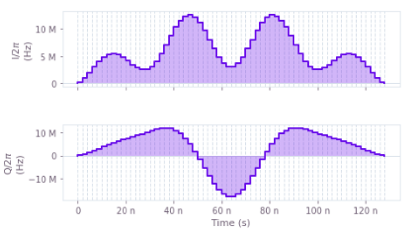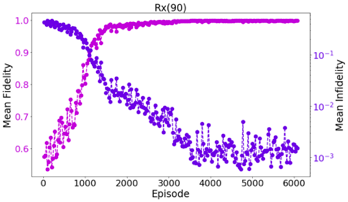Press release
Q-CTRL Hires Defense Industry Leader to Expand Business Partnerships in the U.S. and U.K.
April 16, 2024

Michael J. Biercuk, Yuval Baum, Andre Carvalho, Sean Howell, Michael R. Hush: Q-CTRL, Sydney & Los Angeles; Nate Earnest-Noble: IBM Research
Anyone who experiments with real quantum computers can attest that today’s systems - as important as they are for research - are far from perfect. Addressing the challenge of hardware instability has been a huge driver for the research field for decades.
Quantum Error Correction is of course one of the most promising long-term strategies to enable the realization of large-scale quantum computing. Despite enormous progress demonstrating the fundamentals of QEC, costly resource requirements mean that large-scale error-corrected quantum computers remain a target for the future. In the nearer term quantum firmware provides a validated approach to mitigate errors in individual hardware elements and individual qubit operations using the concepts of quantum optimal control.
These techniques permit the implementation of error-robust quantum logic operations by exploiting symmetries in the mathematical space of quantum-logic operations in order to cancel error accumulation. Key to their value is the reality that hardware generally exhibits structured noise - noise which exhibits strong correlations in space and time. These errors - arising from drifts in hardware or slowly varying ambient field fluctuations - are actually not very well suited to most quantum error correction schemes, but are adeptly handled by quantum control. Thus, we see low-level quantum firmware as essential both now and into the future as a complement to QEC in the long term.
Some approaches to generating error-robust quantum logic are familiar from their origins in NMR, but quantum control has matured substantially and now many groups routinely use error-suppressing gates as a default. For instance, IBM’s systems employ both DRAG and an “Echoed cross-resonance” gate in order to take advantage of the physics of coherent averaging. So what’s new?
Enabling users to test and implement novel error-robust controls has recently been facilitated by the analog-layer programming provided by Qiskit Pulse - one of the first attempts to provide analog-layer access to a quantum computer over a cloud API.
Instead of only defining circuits composed of pre-calibrated gate-sets, analog-layer access permits the user to program the time-domain structure of the control fields employed to enact quantum logical operations. In the context of single-qubit gates on IBM’s superconducting quantum computers this translates to the ability to program the modulation-hardware employed to enact arbitrary control over the phase and amplitude of pulsed microwave signals. Through this access users may define custom pulses and even implement new modes of hardware operation beyond the gate model.
The team at Q-CTRL has been working with IBM to integrate a new class of error-robust pulses directly into IBM quantum computers using Qiskit Pulse. These pulses are designed to mitigate the dominant sources of error seen in these systems like qubit-frequency detuning, leakage, and microwave-amplitude fluctuations. The objective, of course, is to improve the performance of the underlying hardware by reducing gate errors, reducing device variability, and extending hardware uptime between calibrations.
The creation of new error-robust pulses constitutes two main steps: (i) Numeric Optimization and (2) Hardware Calibration.
Numeric Optimization: Starting with a Hamiltonian model of IBM hardware, we numerically create new kinds of quantum logic operations designed to be robust against various sources of error. We use a custom software package which enables a user to perform optimizations incorporating realistic hardware constraints via a cloud-compute engine. Most importantly, we include smoothing filters which account for the finite bandwidth of the dilution fridges that keep superconducting quantum computers cold (to be forthright it took a fair bit of experimentation to determine the best filtering parameters). Control waveforms are described in terms of $(I, Q)$ pairs which define the rotation amplitude in a common decomposition used in microwave engineering. You can see a representative error-robust smoothed pulse below which involves shaping both the amplitude and phase of the pulse.

Hardware Calibration: In Qiskit Pulse, analog waveforms are defined in terms of dimensionless variables $A = A_I + i A_Q$ with $A_{I,Q} \in [-1,1],\;\;|A|\le 1$; We have developed our own protocol to establish the map $(A_I, A_Q) \longleftrightarrow (I, Q)$, from programming amplitudes to control-pulse amplitudes in the laboratory frame. We first coarsely calibrate the channels $(A_I, A_Q)$, by measuring Rabi oscillations in the time-domain using square, fixed-amplitude pulses to find the functional dependence $(A_I, A_Q) \leftrightarrow (I, Q)$. Fine calibration of the absolute and relative scaling of the $I$ and $Q$ channels is achieved by expressing the control waveform using two scaling factors as $ S_{amp} (S_{rel} I(t) + i Q(t))$, and identifying these scaling factors through experiment. The calibration routine then provides a way to predistort waveforms in order to account for nonlinearities and cross-couplings in the hardware response.
How well do the gates work? In short, our results consistently reveal that controls designed to be robust against amplitude or dephasing errors, and including a sinc-smoothing-function with $30$ MHz bandwidth, outperform default calibrated DRAG operations under native noise conditions. Measures of the effective-error-per-gate extracted from experiment demonstrate improvements up to and exceeding $10\times$ in single-qubit coherent error rates, with average device-wide performance improvements $\sim 5\times$ on Valencia.
The same pulses reduce gate-variability between qubits and over time by $\sim10\times$ as well. So even when the best performing gate on the device is only marginally improved, we can bring all of the qubits into a narrow performance window around that best qubit. No more enormous variability across qubits. Moreover, we’ve seen an extension of the useful calibration window to approximately one week, as compared with the daily calibration cycle for the default gates.
Benefits are even larger when we fully parallelize operations. In general compilers serialize operations in order to minimize ever-present crosstalk errors. With appropriate optimized pulses there’s no need for that. The robust optimized gates under parallel operations outperform the serially applied default pulses across all five qubits on Valencia. The gates we created appear to suppress both ambient noise and the sources of crosstalk that arise under parallel operations.
You can see a nice summary of these results below. Here the colorscale indicates the extracted error rate - dark is low and bright is high. Under parallel operations the optimized pulses perform quite similarly across qubits and over several days. By contrast, the default gates have much higher error rates, vary considerably between qubits, and fluctuate daily despite being recalibrated every day. The variability in space and time you see here is reduced more than 8 times using optimized amplitude-noise-robust pulses.

But wait there’s more. We also pursue a completely model-free approach to quantum-control optimization. In this case our work is based on Reinforcement Learning in which we employ a neural network to discover how to efficiently control a quantum computer exclusively through experiments on the system.
We don’t provide any optimization parameters or underlying model of the physics we’re trying to exploit. Instead, we provide the algorithm a set of actions it can take, the ability to perform experiments, and then a decision engine to determine what to do with the new measurement information it’s gained. The system learns all of the relevant physics and hardware constraints, simply by attempting to satisfy a reward function. As always, the “magic” lies in the means of learning and convergence, both of which we’ll be describing in a forthcoming manuscript. But the results are quite extraordinary.
When tasked with discovering the analog-layer controls that would implement a driven X90 gate - the fundamental building block for all U3 generalized operations within Qiskit - the reinforcement learning algorithm discovers novel pulses that outperform the IBM default. You can see how the learner converges on solutions which show high state-fidelities.

We find operations which are 20% faster than the IBM default and provide randomized-benchmarking performance better than or comparable to the default. Vitally the output pulses aren’t trivial like a smoothed square pulse. Exactly what physics is being exploited is not exactly clear, because the waveforms produced are heavily distorted by the time they reach the qubits.
Even better, with these pulses we observe that the useful calibration window is at least eight days! We believe that the fact training must be completed over multiple measurement days on IBM hardware - primarily due to queues for access - may have inadvertently allowed the learner to design pulses robust against drifts. We’ve recently discovered high-performing pulses nearly three times as fast as the default and have even discovered new two-qubit entangling operations! Hold tight for a forthcoming manuscript.
Overall these are highly motivating initial demonstrations that Boulder Opal - integrated directly into hardware via analog-layer programming - can open up new opportunities in quantum computing research, and accelerate progress in the field. We’re really excited to see what else the community can do with our tools!
Sign up for a free trial of Boulder Opal - quantum control infrastructure software for R&D professionals building the future.